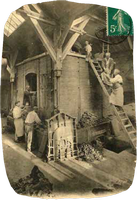Voici les différents panneaux du circuit patrimonial Mélusine :
Sainterie
The Sainterie
Did you know that Vendreuve was home to ‘Paradise’?

Léon MOYNET
(1818-1892)
The Christian Art Manufactory of Vendeuvre-sur-Barse, known as ‘la Sainterie’, was established by the renowned sculptor Léon MOYNET.

The early days of the Sainterie
Initially established in 1842 in Magny-Fouchard (Aube region), he developed religious terracotta statuary centred around the manufacture of two altars for the parish. His technique, using moulds, meant that, in contrast to traditional wood or stone sculpture, he was able to produce multiple and therefore cheaper editions at a time when the demand for statues was very high.
In 1844, he started producing statues assisted by a handful of workers in a workshop located on the western outskirts of Vendeuvre-sur-Barse. Some structures can still be seen in the vicinity of 77 Avenue de la Libération.

MOYNET, a statuary artist
From 1860, he developed a full-scale industrial complex including a large round kiln and a steam engine to knead the clay.
He reproduced his designs in series and commercialised them through catalogues that were to include photographs from 1869 onwards. He produced several thousand statues each year, appointed 80 employees, and enlisted the help of sculptors to manufacture his designs.
In 1878, the Paris Universal Exhibition allocated him a booth he deemed too small. Consequently, he designed a big exhibition shop for his statues aptly named ‘le Paradis’ (Paradise) which became an attraction for customers and visitors alike.
A few renowned sculptors worked alongside him anonymously: Paul AUBÉ, Eugène MARSON, Ernest TOUSSAINT, and Florentin MEFFROY.

An oven

Paradise

Honoré NICOT
Industrial expansion and decline
In 1890, at the age of 72, MOYNET retired and handed the company over to his accountant Honoré NICOT.
The ‘Sainterie’ continued to develop, particularly internationally, thanks to orders placed by missions. The premises grew with the addition of a new oven, unfortunately, fate struck the NICOTs. Honoré died in 1905, aged 49, and his son Henri was killed during the First World War. The 1905 law on the separation of Church and State and the decline of the worship of Saints marked the beginning of the end for the company. René NICOT diversified his production by making secular statues to no avail. He also tried to produce architectural terracotta pieces in vain. The production of statues came to a halt in 1961.
The memory of this industry is perpetuated by a local association, ‘Artho’, pending the opening of a ‘Sainterie and saintiers’ Museum.






